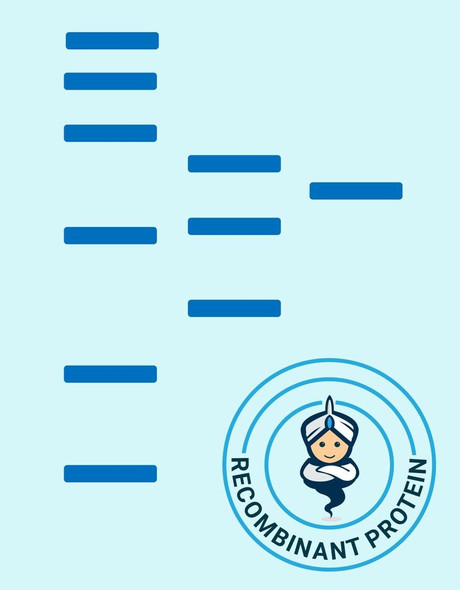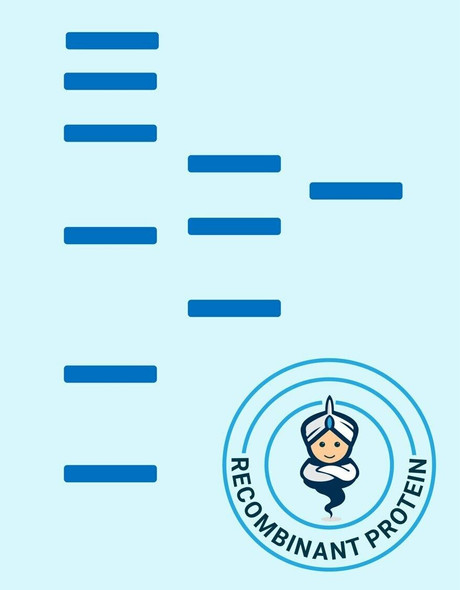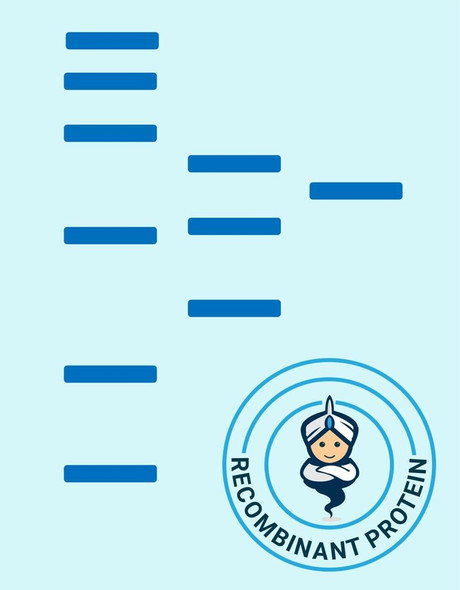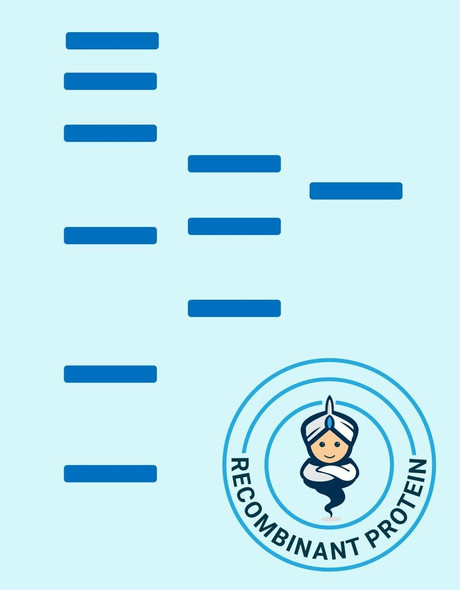Mouse MCP 1 Recombinant Protein (RPPB1188)
- SKU:
- RPPB1188
- Product type:
- Recombinant Protein
- Size:
- 10ug
- Species:
- Mouse
- Target:
- MCP 1
- Synonyms:
- Small inducible cytokine A2
- CCL2
- Monocyte chemotactic protein 1
- MCP-1
- Source:
- Escherichia Coli
- Uniprot:
- P10148
Description
| Product Name: | Mouse MCP 1 Recombinant Protein |
| Product Code: | RPPB1188 |
| Size: | 10µg |
| Species: | Mouse |
| Target: | MCP 1 |
| Synonyms: | Small inducible cytokine A2, CCL2, Monocyte chemotactic protein 1, MCP-1, Monocyte chemoattractant protein 1, Monocyte chemotactic and activating factor, MCAF, Monocyte secretory protein JE, HC11, chemokine (C-C motif) ligand 2, MCP1, SCYA2, GDCF-2, SMC-CF, HSMCR30, MGC9434, GDCF-2 HC11, Platelet-derived growth factor-inducible protein JE. |
| Source: | Escherichia Coli |
| Physical Appearance: | Sterile Filtered White lyophilized (freeze-dried) powder. |
| Formulation: | The protein was lyophilized with no additives. |
| Solubility: | It is recommended to reconstitute the lyophilized Monocyte Chemotactic Protein-1 in sterile 18M?-cm H2O not less than 100µg/ml, which can then be further diluted to other aqueous solutions. |
| Stability: | Lyophilized MCP-1 although stable at room temperature for 3 weeks, should be stored desiccated below -18°C. Upon reconstitution CCL2 should be stored at 4°C between 2-7 days and for future use below -18°C. For long term storage it is recommended to add a carrier protein (0.1% HSA or BSA).Please prevent freeze-thaw cycles. |
| Purity: | Greater than 90.0% as determined by:(a) Analysis by RP-HPLC.(b) Analysis by SDS-PAGE. |
| Amino Acid Sequence: | The sequence of the first five N-terminal amino acids was determined and was found to be Gln-Pro-Asp-Ala-Val |
| Biological Activity: | The biological activity was determined by calculating its ability to chemoattract Balb/C mouse spleen MNCs at 1.0-20.0 ng/ml. |
Chemokine (C-C motif) ligand 2 (CCL2) is a small cytokine belonging to the CC chemokine family that is also known as monocyte chemotactic protein-1 (MCP-1). It is found at the site of tooth eruption and bone degradation. In the bone, CCL2 is expressed by mature osteoclasts and osteoblasts and is under the control of nuclear factor kB (NFkB). CCL2 recruits immune cells, such as monocytes, to sites of tissue injury and infection. This chemokine is produced as a protein precursor containing signal peptide of 23 amino acidsand a mature peptide of 76 amino acids. It is a monomeric polypeptide, with a molecular weight of approximately 13kDa. As with many other CC chemokines, CCL2 is located on chromosome 17 in humans. The cell surface receptors that bind CCL2 are CCR2 and CCR5.
Monocyte Chemotactic Protein-1 Mouse Recombinant produced in E.Coli is a single,non-glycosylated, polypeptide chain containing 125 amino acids and having a molecular mass of 14 kDa. The MCP-1 is purified by proprietary chromatographic techniques.
| UniProt Protein Function: | CCL13: Chemotactic factor that attracts monocytes, lymphocytes, basophils and eosinophils, but not neutrophils. Signals through CCR2B and CCR3 receptors. Plays a role in the accumulation of leukocytes at both sides of allergic and non-allergic inflammation. May be involved in the recruitment of monocytes into the arterial wall during the disease process of atherosclerosis. May play a role in the monocyte attraction in tissues chronically exposed to exogenous pathogens. By IL1/interleukin-1 and TNF. Widely expressed. Found in small intestine, thymus, colon, lung, trachea, stomach and lymph node. Low levels seen in the pulmonary artery smooth muscle cells. Belongs to the intercrine beta (chemokine CC) family. |
| UniProt Protein Details: | Protein type:Secreted; Secreted, signal peptide; Motility/polarity/chemotaxis; Chemokine Cellular Component: extracellular space; rough endoplasmic reticulum; cell soma; perinuclear region of cytoplasm; endocytic vesicle; dendrite; cytoplasm; extracellular region; perikaryon; synapse; nerve terminal Molecular Function:heparin binding; protein binding; G-protein-coupled receptor binding; chemokine activity; CCR2 chemokine receptor binding; cytokine activity Biological Process: positive regulation of cell adhesion; positive regulation of leukocyte migration; positive regulation of collagen biosynthetic process; chemotaxis; positive regulation of synaptic transmission; positive regulation of cellular extravasation; regulation of cell shape; transforming growth factor beta receptor signaling pathway; positive regulation of cell-cell adhesion; response to wounding; angiogenesis; inflammatory response; lymphocyte chemotaxis; neutrophil chemotaxis; cytokine and chemokine mediated signaling pathway; cytoskeleton organization and biogenesis; positive regulation of tumor necrosis factor production; glial cell migration; macrophage chemotaxis; leukocyte migration during inflammatory response; cellular calcium ion homeostasis; negative regulation of angiogenesis; positive regulation of leukocyte mediated cytotoxicity; response to heat; eosinophil chemotaxis; immune response; positive regulation of endothelial cell proliferation; positive regulation of T cell activation; vascular endothelial growth factor receptor signaling pathway; positive regulation of nitric-oxide synthase biosynthetic process |
| NCBI Summary: | This gene is one of several cytokine genes clustered on chromosome 11. Chemokines are a superfamily of secreted proteins involved in immunoregulatory and inflammatory processes. The superfamily is divided into four subfamilies based on the arrangement of N-terminal cysteine residues of the mature peptide. This chemokine is a member of the CC subfamily which is characterized by two adjacent cysteine residues. This cytokine displays chemotactic activity for monocytes and memory T cells but not for neutrophils. The human ortholog has been implicated in the pathogenesis of diseases characterized by monocytic infiltrates, such as psoriasis, rheumatoid arthritis, and atherosclerosis. [provided by RefSeq, Sep 2015] |
| UniProt Code: | P10148 |
| NCBI GenInfo Identifier: | 126844 |
| NCBI Gene ID: | 20296 |
| NCBI Accession: | P10148.1 |
| UniProt Secondary Accession: | P10148,Q9QYD7, |
| UniProt Related Accession: | P10148 |
| Molecular Weight: | 16,326 Da |
| NCBI Full Name: | C-C motif chemokine 2 |
| NCBI Synonym Full Names: | chemokine (C-C motif) ligand 2 |
| NCBI Official Symbol: | Ccl2 |
| NCBI Official Synonym Symbols: | JE; HC11; MCAF; MCP1; MCP-1; Scya2; Sigje; SMC-CF; AI323594 |
| NCBI Protein Information: | C-C motif chemokine 2; small inducible cytokine A2; small-inducible cytokine A2; monocyte chemotactic protein 1; monocyte chemoattractant protein 1; monocyte chemoattractant protein-1; platelet-derived growth factor-inducible protein JE |
| UniProt Protein Name: | C-C motif chemokine 2 |
| UniProt Synonym Protein Names: | Monocyte chemoattractant protein 1; Monocyte chemotactic protein 1; MCP-1; Platelet-derived growth factor-inducible protein JE; Small-inducible cytokine A2 |
| Protein Family: | C-C motif chemokine |
| UniProt Gene Name: | Ccl2 |
| UniProt Entry Name: | CCL2_MOUSE |










